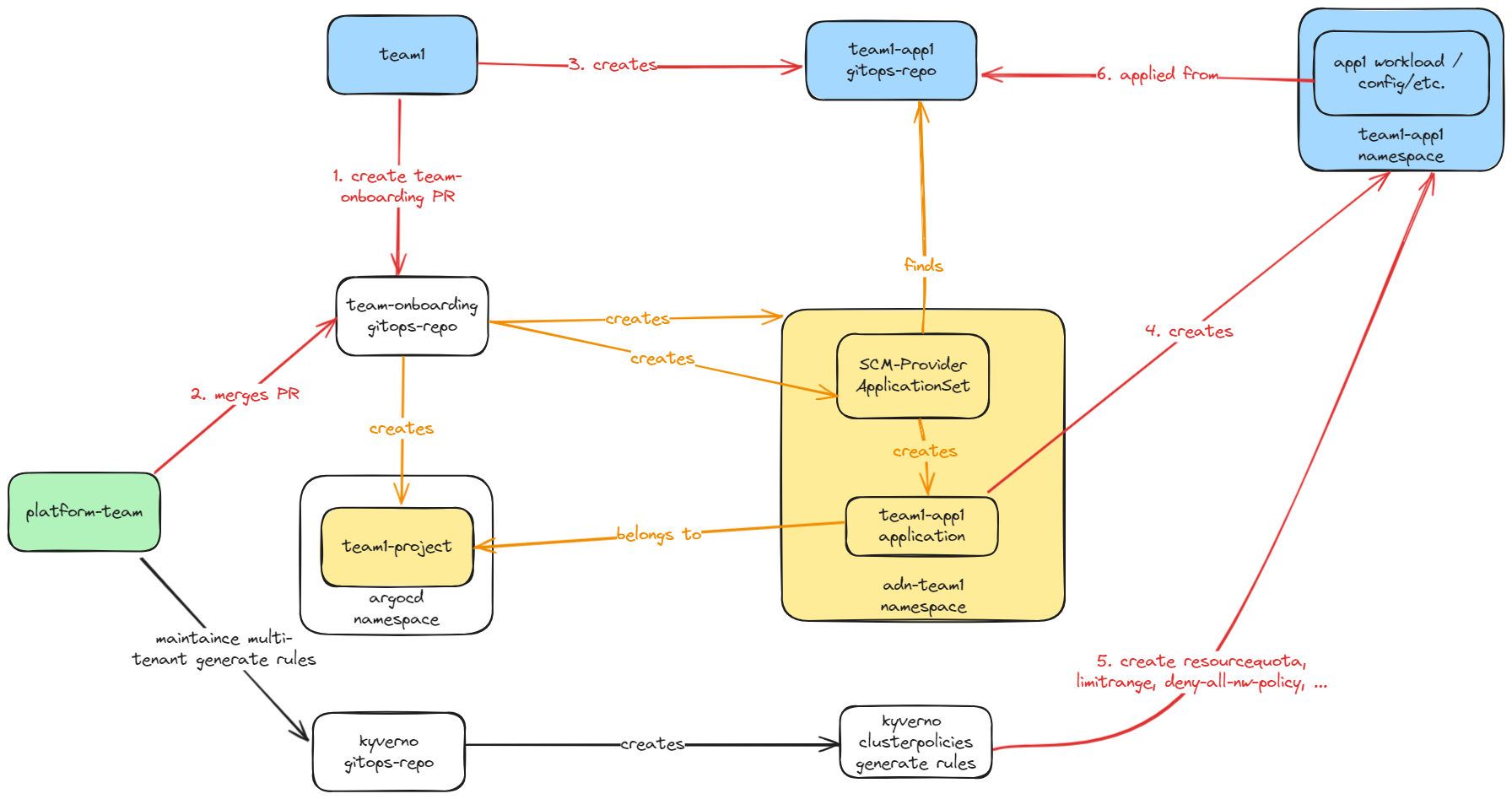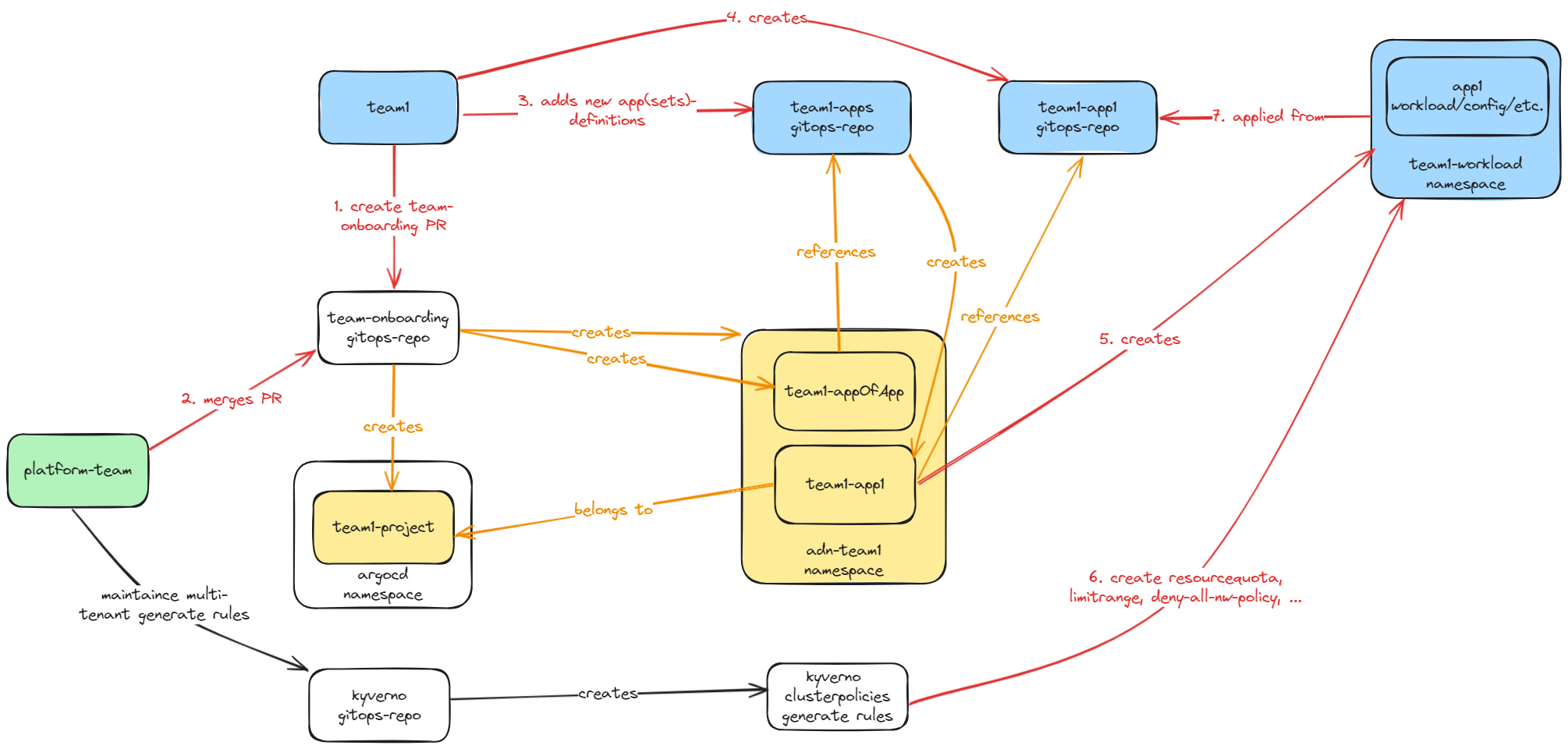Onboarding teams and apps
According to the ADR Onboarding teams in a gitops way we are currently working with the approach apps-in-any-namespace and multi-tenant kyverno-policies.
For detailed explanations how this approach works, please read through the ADR.
Here we want to give you a good overview how this approach works and what platform-teams and dev-teams need to do.
Overview - Onboarding teams and apps with ApplicationSets

While this picture seems to be complex, it actually shows that onboarding teams and apps is just as easy as follows:
- dev-team creates a PR to the argocd gitops-repo with some team-information
- platform-team reviewes this PR and merges it
- dev-team then creates its own app gitops-repo
that is actually everything what people need to do!
The internal operators, controllers and a little bit of love and magic then
- creates the new namespace for this new app
- kyverno generate rules create some resources to avoid some noisy neighbors like resourcequotas, limitranges and deny-all-network-policies
- and all kubernetes resources for this new app get applied in this namespace
Overview - Onboarding teams and apps with App-Of-Apps

Also this picture is probably a little bit overwhelming in the first place, but in the end there is just one additional step here
- dev-team creates a PR to the argocd gitops-repo with some team-information
- platform-team reviewes this PR and merges it
- dev-team then creates its own app-of-apps gitops-repo (this step is added in this scenario)
- dev-team then creates its own app gitops-repo which is referenced in an app-definition in step 3
Then (again) the platform does everything it is build for and
- creates the new namespace for this new app
- kyverno generate rules create some resources to avoid some noisy neighbors like resourcequotas, limitranges and deny-all-network-policies
- and all kubernetes resources for this new app get applied in this namespace
This approach uses App-Of-Apps instead of ApplicationSets to onboard new apps in a gitops-way. It is up to you or your dev-teams what they like more. The good thing is, each dev-team can decide for themselves how they want to onboard their apps.
Details for onboarding new teams
add new team and configuration in team-onboarding chart
add a new team in this teams-array with the corresponding attributes.
app-onboarding options
with appOfAppsRepo we define a gitops-repo where the dev-team can create its own application definitions. Still, it is automatically restricted that these applications can only belong to the teams argocd app-project.
with multiStageKargoAppSet an ApplicationSet is automatically created in the adn-<team> namespace which constantly searches for corresponding gitops-repos and adds new applications automatically in the adn-<team> namespace. This special ApplicationSet creates an application per stage defined in an app-stages.yaml like this example and adds kargo project, warehouse and stages to the cluster.
check if multi-tenant kyverno-policies get applied
we set them in kyverno-policies array
currently there is just a limitrange and resourcequota resource generated, networkpolicies and others will follow.
Details for onboarding new apps
As a dev-team you then can add new applications in different ways now depending on the knowledge and flexibility of your dev-team.
one simple deployment-descriptor with appset and base-chart provided by platform-team automatically
tbd .. with an "all-in-one-flexible-helm-chart", an appset with multi-source app and a simple deployment-descriptor like https://github.com/jkleinlercher/just-one-yaml-deployment/blob/main/apps/my-aspnetapp/deployit.yaml you can automatically generate new apps.
one simple deployment-descriptor for multi-stage app with kargo project
create an app like team1-demo-app1 with this app-stages.yaml in it.
The repo organization must match the organization defined in the team-onboarding attribute "teams.[].multiStageKargoAppSet.organization" and the repo-name must start with the team name (e.g. team1-demo-app).
Then apps for each stage in the app-stage.yaml get created, and a corresponding kargo project, warehouse and stages which is responsible for git-promotion to production.
This approach does lots of things out-of-the-box and is good, as long as you are fine with the standards the ApplicationSet and the Application-Helm-Chart define.
use some platform helm-chart as a source for an applicationset
the same Application-Helm-Chart as in the option before can also be used directly in an ApplicationSet which the dev-team just creates in ins team-app-of-apps-repo, like https://github.com/suxess-it/team1-apps/blob/main/k3d-apps/example-multi-stage-app-with-kargo.yaml.
describe in
- https://github.com/suxess-it/kubriX/blob/main/backstage-resources/adr/0002-gitops-onboarding-apps.md#applicationset-with-parent-helm-chart
- or in https://github.com/suxess-it/kubriX/blob/main/backstage-resources/adr/0002-gitops-onboarding-apps.md#applicationset-with-configjson-representing-a-parent-helm-chart
deploy applications as you want
just deploy an argocd app definition and other K8s resources in your team-app-of-apps-repo as defined in the team-onboarding attribute "teams.[].appOfAppsRepo".